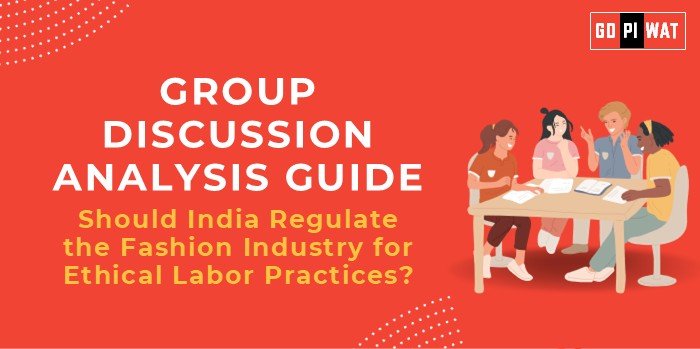📋 Group Discussion (GD) Analysis Guide: Should India Regulate the Fashion Industry for Ethical Labor Practices?
🌐 Introduction to the Topic
- 💡 Context: The global fashion industry generates $2.5 trillion annually but is often criticized for poor labor practices. In India, a significant garment manufacturing hub, ethical labor concerns such as low wages, unsafe conditions, and child labor demand attention.
- 📜 Background: India’s fashion industry contributes around 7% to GDP and employs over 45 million workers, many of whom work in informal setups. Ethical labor regulation has emerged as a priority amidst growing consumer awareness and international scrutiny.
📊 Quick Facts and Key Statistics
- 📈 Contribution to GDP: 7% – Highlights the economic importance of fashion in India.
- 👔 Employment Numbers: 45 million workers – Indicates the industry’s labor-intensive nature.
- ⚖️ Wage Gap: 65% of workers earn less than minimum wage – Highlights ethical issues.
- 🌍 Global Comparison: Ethical fashion market growth at 8.3% CAGR – Reflects consumer preference for sustainable practices.
- 🚸 Child Labor Cases: Over 5% of India’s garment workers are minors – Alarming statistic for social policy advocates.
👥 Stakeholders and Their Roles
- 🏛️ Government: Policy formulation, enforcement of labor laws, and international compliance.
- 🏭 Private Sector: Adoption of ethical practices, worker welfare programs, and compliance with global standards.
- 🌐 Non-Governmental Organizations (NGOs): Advocacy, monitoring, and reporting on violations.
- 🛍️ Consumers: Driving demand for ethical fashion through informed purchasing decisions.
- 📚 International Organizations: Setting ethical benchmarks, such as ILO’s labor standards.
🏆 Achievements and Challenges
✨ Achievements
- 🌱 Rising Ethical Brands: Increased consumer preference for ethical brands like Fabindia and No Nasties.
- 📜 Policy Initiatives: Draft Labour Codes aimed at formalizing and protecting workers.
- 🤝 Global Partnerships: Indian companies collaborating with international brands for ethical supply chains.
⚠️ Challenges
- 🔍 Weak Enforcement: Despite strong labor laws, enforcement remains inconsistent.
- ⚙️ Supply Chain Complexity: Tracking ethical practices across informal sectors is difficult.
- 💸 Economic Pressures: Balancing labor rights with cost competitiveness.
🌍 Global Comparisons
- 🇧🇩 Bangladesh: High compliance with ILO standards due to global brand pressure.
- 🇨🇳 China: Strong policies but limited focus on labor welfare compared to environmental standards.
📚 Case Study
- 🏭 Tirupur Cluster (Tamil Nadu): Known for its garment exports, faced criticism for exploitative conditions but is now adopting labor-friendly policies due to international buyer pressure.
💬 Structured Arguments for Discussion
- 💪 Supporting Stance: “Regulating the fashion industry ensures sustainable growth, better working conditions, and global competitiveness.”
- ⚖️ Opposing Stance: “Excessive regulation may raise costs, making Indian products less competitive globally.”
- 🤝 Balanced Perspective: “While regulation is necessary, it should prioritize worker welfare without hampering economic growth.”
📚 Effective Discussion Approaches
- 💡 Opening Approaches:
- 📊 “45 million workers contribute to India’s fashion industry, yet many lack basic rights.”
- 📚 “Tirupur’s shift from unethical practices to sustainable growth proves regulation is feasible.”
- 🤔 Counter-Argument Handling:
- ⚖️ Acknowledge economic concerns but suggest phased implementation.
- 🌍 Emphasize global consumer demand for ethical practices.
🔎 Strategic Analysis of Strengths and Weaknesses
- 💪 Strengths: Large workforce, global market share, growing consumer awareness.
- 🛑 Weaknesses: Poor enforcement, informal sector challenges.
- 🌟 Opportunities: International collaborations, growing ethical market.
- ⚠️ Threats: Cost pressures, potential loss of global market share.
🎓 Connecting with B-School Applications
- 📊 Real-World Applications: Projects on ethical supply chain management, sustainability in operations, and labor welfare policies.
- ❓ Sample Interview Questions:
- 💡 “What steps can India take to improve ethical labor standards in fashion?”
- 📈 “How can regulation affect India’s position in the global fashion market?”
- 📝 Insights for Students: Ethical labor practices are critical in sustainable business and CSR strategies.


